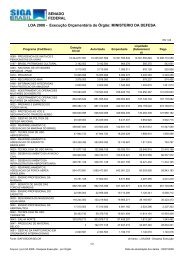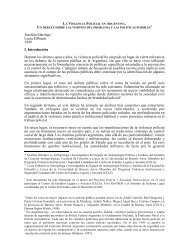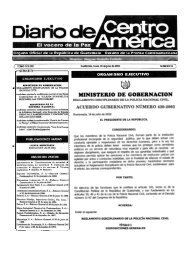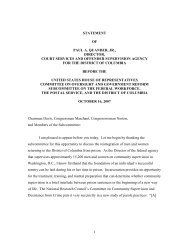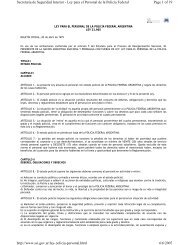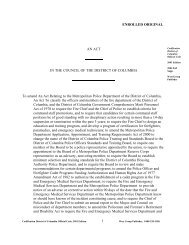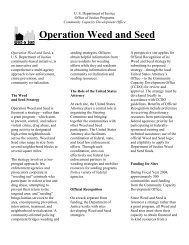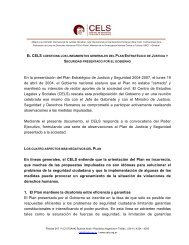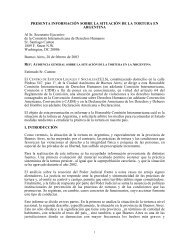Venezuela: The Life and Times of the Party System - Political ...
Venezuela: The Life and Times of the Party System - Political ...
Venezuela: The Life and Times of the Party System - Political ...
You also want an ePaper? Increase the reach of your titles
YUMPU automatically turns print PDFs into web optimized ePapers that Google loves.
vote. <strong>The</strong>se results seemed to build on <strong>the</strong> pattern set in 1963 when five strong competitors<br />
divided <strong>the</strong> vote. COPEI took power in that year, <strong>the</strong> first time an opposition party had ever<br />
defeated government <strong>and</strong> entered <strong>of</strong>fice in free elections. COPEI’s victory came on a very<br />
narrow plurality, with its perennial c<strong>and</strong>idate (Rafael Caldera) squeaking into <strong>of</strong>fice with barely 29<br />
percent <strong>of</strong> <strong>the</strong> vote, <strong>the</strong> smallest winning percentage in modern history.<br />
<strong>The</strong> 1968 election was a decisive turning point. Although competition remained high in<br />
later years, fragmentation suddenly disappeared. <strong>The</strong> share <strong>of</strong> presidential votes going to “O<strong>the</strong>r”<br />
(o<strong>the</strong>r than AD or COPEI) dropped from 42.2 percent in 1968 to 12.4 percent in 1973 <strong>and</strong> since<br />
<strong>the</strong>n has headed down, with AD <strong>and</strong> COPEI successfully pushing <strong>the</strong>ir rivals to <strong>the</strong> margin.<br />
Electoral fragmentation was not <strong>the</strong> only thing left behind with <strong>the</strong> elections <strong>of</strong> 1968. <strong>The</strong><br />
character <strong>of</strong> viable political parties also changed. <strong>The</strong> first three national elections under<br />
democratic rule gave substantial place to electoral phenomena, loosely organized political<br />
vehicles ga<strong>the</strong>red around <strong>the</strong> c<strong>and</strong>idacy <strong>of</strong> one striking individual. In 1958, this role was filled by<br />
Admiral Wolfgang Larrazábal, popular head <strong>of</strong> <strong>the</strong> Provisional Junta that replaced Perez Jimenez.<br />
As noted earlier, Larrazábal went on to found his own party, Fuerza Democrática Popular (FDP),<br />
in 1963, a year that also witnessed <strong>the</strong> phenomenon <strong>of</strong> Arturo Uslar Pietri, a well-known writer,<br />
who later founded his own party, Frente Nacional Democrático (FND). <strong>The</strong>se two made <strong>the</strong>ir last<br />
st<strong>and</strong> in 1968 when <strong>the</strong>y joined URD’s declining forces in a coalition that took about 20 percent <strong>of</strong><br />
<strong>the</strong> total vote. Approximately ano<strong>the</strong>r fifth went to Luis Beltran Prieto, whose Movimiento<br />
Electoral del Pueblo (MEP) emerged that year as a result <strong>of</strong> AD’s worst <strong>and</strong> (so far) last division.<br />
Even <strong>the</strong> former dictator Marcos Perez Jimenez got substantial votes that year, as <strong>the</strong> Cruzada<br />
Cívica Nacionalista (CCN) elected almost a tenth <strong>of</strong> <strong>the</strong> Chamber <strong>of</strong> Deputies (on <strong>the</strong> basis <strong>of</strong> a<br />
slightly smaller popular vote) in his name.<br />
In <strong>the</strong> decade after 1968, electoral phenomena disappeared, AD rebounded, <strong>and</strong> COPEI<br />
continued to grow, peaking (in percentage terms) in <strong>the</strong> 1978 presidential vote (Tables 2 <strong>and</strong> 4).<br />
That pattern has continued to <strong>the</strong> present, with competition between AD <strong>and</strong> COPEI thoroughly<br />
dominating <strong>the</strong> political scene. Before we comment in detail on <strong>the</strong> nature <strong>of</strong> competition<br />
between <strong>the</strong>se two parties, two points are required to set <strong>the</strong> whole pattern in context.<br />
First, bear in mind that all this has taken place in <strong>the</strong> context <strong>of</strong> an exp<strong>and</strong>ing electorate<br />
that has more than matched <strong>the</strong> growth <strong>of</strong> <strong>the</strong> population. <strong>The</strong> number <strong>of</strong> registered voters has<br />
grown steadily throughout <strong>the</strong> entire democratic period, although <strong>the</strong> rate <strong>of</strong> increase has slowed<br />
lately, showing margins <strong>of</strong> 31, 25, <strong>and</strong> 18 percent over <strong>the</strong> last three recent elections. Turnout is<br />
high, with abstentions dropping steadily from 1958 to 1973, only to rise again in 1978, reaching<br />
over 18 percent in 1988. (See Table 7. We discuss <strong>the</strong> possible significance <strong>of</strong> rising abstention<br />
below.) This is no mean accomplishment in a country with such a youthful population <strong>and</strong> reflects<br />
deliberate <strong>and</strong> consistent effort.



